Ossi Kaltiokallio
Target Handover in Distributed Integrated Sensing and Communication
Nov 04, 2024Abstract:The concept of 6G distributed integrated sensing and communications (DISAC) builds upon the functionality of integrated sensing and communications (ISAC) by integrating distributed architectures, significantly enhancing both sensing and communication coverage and performance. In 6G DISAC systems, tracking target trajectories requires base stations (BSs) to hand over their tracked targets to neighboring BSs. Determining what information to share, where, how, and when is critical to effective handover. This paper addresses the target handover challenge in DISAC systems and introduces a method enabling BSs to share essential target trajectory information at appropriate time steps, facilitating seamless handovers to other BSs. The target tracking problem is tackled using the standard trajectory Poisson multi-Bernoulli mixture (TPMBM) filter, enhanced with the proposed handover algorithm. Simulation results confirm the effectiveness of the implemented tracking solution.
Batch SLAM with PMBM Data Association Sampling and Graph-Based Optimization
Jul 16, 2024



Abstract:Simultaneous localization and mapping (SLAM) methods need to both solve the data association (DA) problem and the joint estimation of the sensor trajectory and the map, conditioned on a DA. In this paper, we propose a novel integrated approach to solve both the DA problem and the batch SLAM problem simultaneously, combining random finite set (RFS) theory and the graph-based SLAM approach. A sampling method based on the Poisson multi-Bernoulli mixture (PMBM) density is designed for dealing with the DA uncertainty, and a graph-based SLAM solver is applied for the conditional SLAM problem. In the end, a post-processing approach is applied to merge SLAM results from different iterations. Using synthetic data, it is demonstrated that the proposed SLAM approach achieves performance close to the posterior Cram\'er-Rao bound, and outperforms state-of-the-art RFS-based SLAM filters in high clutter and high process noise scenarios.
The Integrated Sensing and Communication Revolution for 6G: Vision, Techniques, and Applications
May 03, 2024



Abstract:Future wireless networks will integrate sensing, learning and communication to provide new services beyond communication and to become more resilient. Sensors at the network infrastructure, sensors on the user equipment, and the sensing capability of the communication signal itself provide a new source of data that connects the physical and radio frequency environments. A wireless network that harnesses all these sensing data can not only enable additional sensing services, but also become more resilient to channel-dependent effects like blockage and better support adaptation in dynamic environments as networks reconfigure. In this paper, we provide a vision for integrated sensing and communication (ISAC) networks and an overview of how signal processing, optimization and machine learning techniques can be leveraged to make them a reality in the context of 6G. We also include some examples of the performance of several of these strategies when evaluated using a simulation framework based on a combination of ray tracing measurements and mathematical models that mix the digital and physical worlds.
Robust Snapshot Radio SLAM
Apr 16, 2024



Abstract:The intrinsic geometric connections between millimeter-wave (mmWave) signals and the propagation environment can be leveraged for simultaneous localization and mapping (SLAM) in 5G and beyond networks. However, estimated channel parameters that are mismatched to the utilized geometric model can cause the SLAM solution to degrade. In this paper, we propose a robust snapshot radio SLAM algorithm for mixed line-of-sight (LoS) and non-line-of-sight (NLoS) environments that can estimate the unknown user equipment (UE) state, map of the environment as well as the presence of the LoS path. The proposed method can accurately detect outliers and the LoS path, enabling robust estimation in both LoS and NLoS conditions. The proposed method is validated using 60 GHz experimental data, indicating superior performance compared to the state-of-the-art.
Millimeter-wave Radio SLAM: End-to-End Processing Methods and Experimental Validation
Dec 21, 2023Abstract:In this article, we address the timely topic of cellular bistatic simultaneous localization and mapping (SLAM) with specific focus on complete processing solutions from raw I/Q samples to user equipment (UE) and landmark location information in millimeter-wave (mmWave) networks. Firstly, we propose a new multipath channel parameter estimation solution which operates directly with beam reference signal received power (BRSRP) measurements, alleviating the need to know the true antenna beampatterns or the underlying beamforming weights. Additionally, the method has built-in robustness against unavoidable antenna sidelobes. Secondly, we propose new snapshot SLAM algorithms that have increased robustness and identifiability compared to prior-art, in practical built environments with complex clutter and multi-bounce propagation scenarios. The performance of the proposed methods is assessed at the 60 GHz mmWave band, via both realistic ray-tracing evaluations as well as true experimental measurements, in an indoor environment. Wide set of offered results clearly demonstrate the improved performance, compared to the relevant prior-art, in terms of the channel parameter estimation as well as the end-to-end SLAM performance. Finally, the article provides the measured 60 GHz data openly available for the research community, facilitating results reproducibility as well as further algorithm development.
MmWave Mapping and SLAM for 5G and Beyond
Nov 29, 2022



Abstract:Device localization and radar-like mapping are at the heart of integrated sensing and communication, enabling not only new services and applications, but can also improve communication quality with reduced overheads. These forms of sensing are however susceptible to data association problems, due to the unknown relation between measurements and detected objects or targets. In this chapter, we provide an overview of the fundamental tools used to solve mapping, tracking, and simultaneous localization and mapping (SLAM) problems. We distinguish the different types of sensing problems and then focus on mapping and SLAM as running examples. Starting from the applicable models and definitions, we describe the different algorithmic approaches, with a particular focus on how to deal with data association problems. In particular, methods based on random finite set theory and Bayesian graphical models are introduced in detail. A numerical study with synthetic and experimental data is then used to compare these approaches in a variety of scenarios.
Doppler Exploitation in Bistatic mmWave Radio SLAM
Aug 22, 2022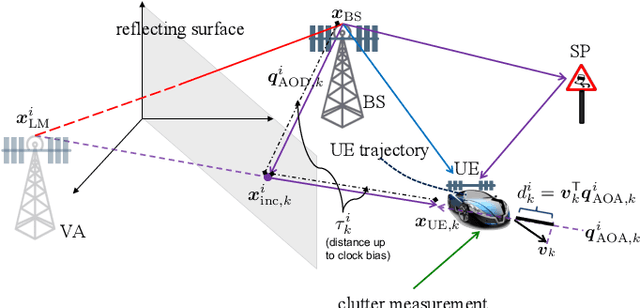
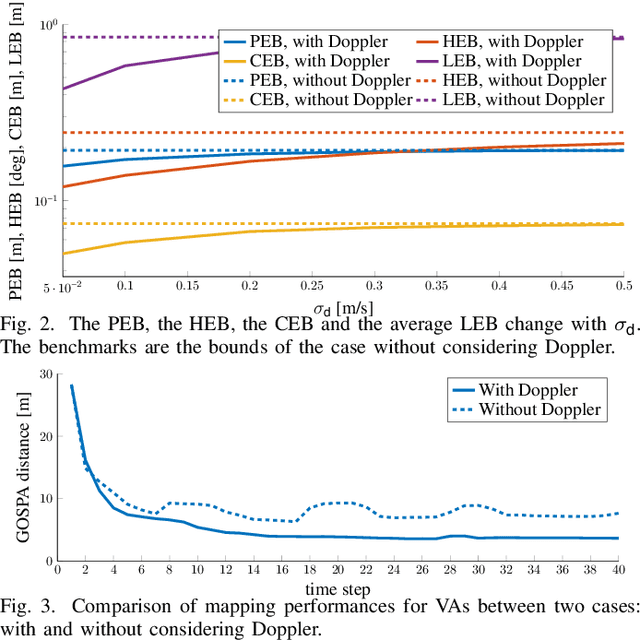
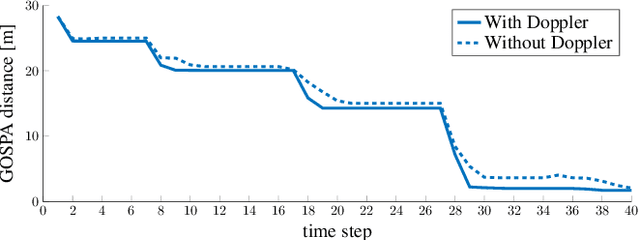
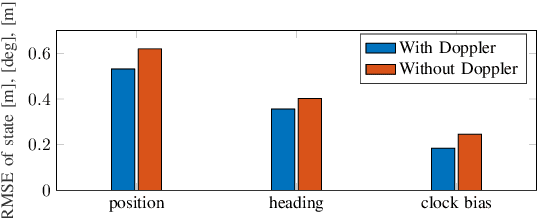
Abstract:Networks in 5G and beyond utilize millimeter wave (mmWave) radio signals, large bandwidths, and large antenna arrays, which bring opportunities in jointly localizing the user equipment and mapping the propagation environment, termed as simultaneous localization and mapping (SLAM). Existing approaches mainly rely on delays and angles, and ignore the Doppler, although it contains geometric information. In this paper, we study the benefits of exploiting Doppler in SLAM through deriving the posterior Cram\'er-Rao bounds (PCRBs) and formulating the extended Kalman-Poisson multi-Bernoulli sequential filtering solution with Doppler as one of the involved measurements. Both theoretical PCRB analysis and simulation results demonstrate the efficacy of utilizing Doppler.
Iterated Posterior Linearization PMB Filter for 5G SLAM
Dec 05, 2021


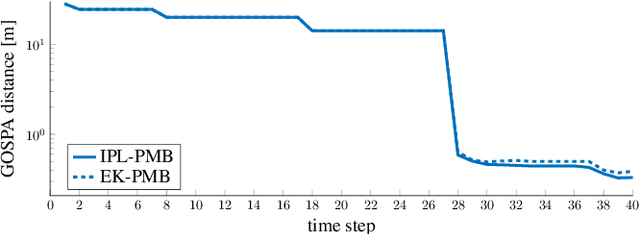
Abstract:5G millimeter wave (mmWave) signals have inherent geometric connections to the propagation channel and the propagation environment. Thus, they can be used to jointly localize the receiver and map the propagation environment, which is termed as simultaneous localization and mapping (SLAM). One of the most important tasks in the 5G SLAM is to deal with the nonlinearity of the measurement model. To solve this problem, existing 5G SLAM approaches rely on sigma-point or extended Kalman filters, linearizing the measurement function with respect to the prior probability density function (PDF). In this paper, we study the linearization of the measurement function with respect to the posterior PDF, and implement the iterated posterior linearization filter into the Poisson multi-Bernoulli SLAM filter. Simulation results demonstrate the accuracy and precision improvements of the resulting SLAM filter.
A Computationally Efficient EK-PMBM Filter for Bistatic mmWave Radio SLAM
Sep 08, 2021



Abstract:Millimeter wave (mmWave) signals are useful for simultaneous localization and mapping (SLAM), due to their inherent geometric connection to the propagation environment and the propagation channel. To solve the SLAM problem, existing approaches rely on sigma-point or particle-based approximations, leading to high computational complexity, precluding real-time execution. We propose a novel low-complexity SLAM filter, based on the Poisson multi-Bernoulli mixture (PMBM) filter. It utilizes the extended Kalman (EK) first-order Taylor series based Gaussian approximation of the filtering distribution, and applies the track-oriented marginal multi-Bernoulli/Poisson (TOMB/P) algorithm to approximate the resulting PMBM as a Poisson multi-Bernoulli (PMB). The filter can account for different landmark types in radio SLAM and multiple data association hypotheses. Hence, it has an adjustable complexity/performance trade-off. Simulation results show that the developed SLAM filter can greatly reduce the computational cost, while it keeps the good performance of mapping and user state estimation.
mmWave Simultaneous Localization and Mapping Using a Computationally Efficient EK-PHD Filter
Aug 03, 2021



Abstract:Future cellular networks that utilize millimeter wave signals provide new opportunities in positioning and situational awareness. Large bandwidths combined with large antenna arrays provide unparalleled delay and angle resolution, allowing high accuracy localization but also building up a map of the environment. Even the most basic filter intended for simultaneous localization and mapping exhibits high computational overhead since the methods rely on sigma point or particle-based approximations. In this paper, a first order Taylor series based Gaussian approximation of the filtering distribution is used and it is demonstrated that the developed extended Kalman probability hypothesis density filter is computationally very efficient. In addition, the results imply that efficiency does not come with the expense of estimation accuracy since the method nearly achieves the position error bound.
 Add to Chrome
Add to Chrome Add to Firefox
Add to Firefox Add to Edge
Add to Edge